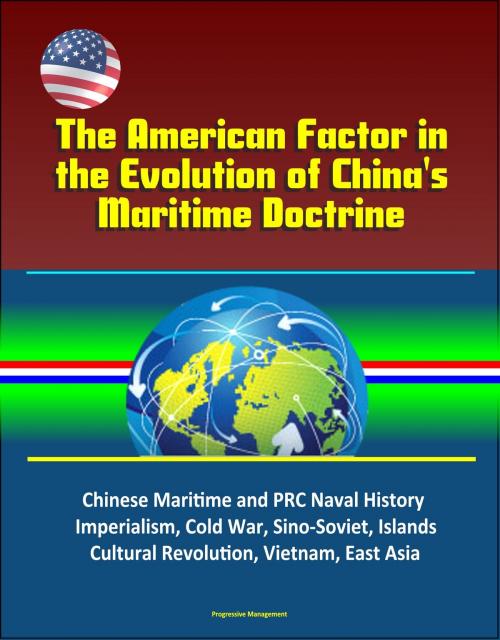The American Factor in the Evolution of China's Maritime Doctrine: Chinese Maritime and PRC Naval History, Imperialism, Cold War, Sino-Soviet, Islands, Cultural Revolution, Vietnam, East Asia
Nonfiction, History, Asian, China, Military, Naval| Author: | Progressive Management | ISBN: | 9781311633842 |
| Publisher: | Progressive Management | Publication: | June 12, 2016 |
| Imprint: | Smashwords Edition | Language: | English |
| Author: | Progressive Management |
| ISBN: | 9781311633842 |
| Publisher: | Progressive Management |
| Publication: | June 12, 2016 |
| Imprint: | Smashwords Edition |
| Language: | English |
This excellent report has been professionally converted for accurate flowing-text e-book format reproduction. Since the birth of the People's Republic of China (PRC) in 1949, American military strategy, foreign policy, and naval presence in East Asia, have all had a significant effect on the evolution of China's naval development, strategy, and maritime doctrine. This thesis will explore the roles, direct and indirect, the United States has played in the development of China's maritime doctrine. China is quickly becoming a regional maritime power and will continue to be a significant factor in the strategic equation of the Western Pacific. The commonly held perception, that China is primarily a continental power, is no longer true as the Chinese navy and merchant marine fleet are today among the largest in the world. As China's national interests expand beyond the Asia-Pacific region, understanding the natural maritime component of those interests will be necessary in the evaluation of China's global aspirations and national strength. This research will be relevant in the assessment of China's maritime doctrine in the 1990s and will allow planners of the Asia-Pacific region to better understand China's often pragmatic approach to naval development and strategy. It will be up to the planners and strategists alike to build on this study and make their own interpretations and applications to policy-making as the future unfolds.
CHAPTER I - INTRODUCTION * A. CHINA'S MARITIME AND NAVAL HISTORY (907-1842) * B. NAVAL HISTORY & FOREIGN IMPERIALISM (1842-1949) * CHAPTER II - OPPOSITION TO THE UNITED STATES: 1949-1953. * A. THE BERTH AND DEVELOPMENT OF THE PRC NAVY * B. THE US - TAIWAN CONNECTION * CHAPTER III - THE COLD WAR PHILOSOPHY: 1953-1968 * A. THE OFFSHORE ISLANDS * B. SINO-SOVIET COOPERATION * C. THE SINO-SOVIET SPLIT (1960) * D. THE CULTURAL REVOLUTION (1966) * CHAPTER IV - NEW ATTENTION TO FOREIGN POLICY: 1968-1976 * A. THE PRC NAVY IN VIETNAM * B. THE FALL OF LIN BIAO * C. THE PEOPLE'S WAR AT SEA * D. SHAPING OF A NEW FOREIGN POLICY * CHAPTER V - NAVAL REFORM AND MODERNIZATION: 1976-1989 * A. NAVAL ACCOMPLISHMENTS AND DEFICIENCIES * B. US-PRC STRATEGIC COOPERATION * C. ECONOMIC REFORM: THE NATURAL MARITIME COMPONENT * CHAPTER VI - AFTER THE COLD WAR: 1989-1993 * A. THE IMPACT OF TIANANMEN SQUARE * B. AFTER THE GULF WAR: THE IMPACT OF TECHNOLOGY * C. THE PRC NAVY IN 1993 * CHAPTER VII - CONCLUSIONS: 1993 AND BEYOND * A. US NAVAL PRESENCE IN EAST ASIA * B. FUTURE CONSIDERATIONS * 1. Prospects For Multilateral Maritime Security * 2. Challenges and Opportunities * LIST OF REFERENCES
This excellent report has been professionally converted for accurate flowing-text e-book format reproduction. Since the birth of the People's Republic of China (PRC) in 1949, American military strategy, foreign policy, and naval presence in East Asia, have all had a significant effect on the evolution of China's naval development, strategy, and maritime doctrine. This thesis will explore the roles, direct and indirect, the United States has played in the development of China's maritime doctrine. China is quickly becoming a regional maritime power and will continue to be a significant factor in the strategic equation of the Western Pacific. The commonly held perception, that China is primarily a continental power, is no longer true as the Chinese navy and merchant marine fleet are today among the largest in the world. As China's national interests expand beyond the Asia-Pacific region, understanding the natural maritime component of those interests will be necessary in the evaluation of China's global aspirations and national strength. This research will be relevant in the assessment of China's maritime doctrine in the 1990s and will allow planners of the Asia-Pacific region to better understand China's often pragmatic approach to naval development and strategy. It will be up to the planners and strategists alike to build on this study and make their own interpretations and applications to policy-making as the future unfolds.
CHAPTER I - INTRODUCTION * A. CHINA'S MARITIME AND NAVAL HISTORY (907-1842) * B. NAVAL HISTORY & FOREIGN IMPERIALISM (1842-1949) * CHAPTER II - OPPOSITION TO THE UNITED STATES: 1949-1953. * A. THE BERTH AND DEVELOPMENT OF THE PRC NAVY * B. THE US - TAIWAN CONNECTION * CHAPTER III - THE COLD WAR PHILOSOPHY: 1953-1968 * A. THE OFFSHORE ISLANDS * B. SINO-SOVIET COOPERATION * C. THE SINO-SOVIET SPLIT (1960) * D. THE CULTURAL REVOLUTION (1966) * CHAPTER IV - NEW ATTENTION TO FOREIGN POLICY: 1968-1976 * A. THE PRC NAVY IN VIETNAM * B. THE FALL OF LIN BIAO * C. THE PEOPLE'S WAR AT SEA * D. SHAPING OF A NEW FOREIGN POLICY * CHAPTER V - NAVAL REFORM AND MODERNIZATION: 1976-1989 * A. NAVAL ACCOMPLISHMENTS AND DEFICIENCIES * B. US-PRC STRATEGIC COOPERATION * C. ECONOMIC REFORM: THE NATURAL MARITIME COMPONENT * CHAPTER VI - AFTER THE COLD WAR: 1989-1993 * A. THE IMPACT OF TIANANMEN SQUARE * B. AFTER THE GULF WAR: THE IMPACT OF TECHNOLOGY * C. THE PRC NAVY IN 1993 * CHAPTER VII - CONCLUSIONS: 1993 AND BEYOND * A. US NAVAL PRESENCE IN EAST ASIA * B. FUTURE CONSIDERATIONS * 1. Prospects For Multilateral Maritime Security * 2. Challenges and Opportunities * LIST OF REFERENCES















